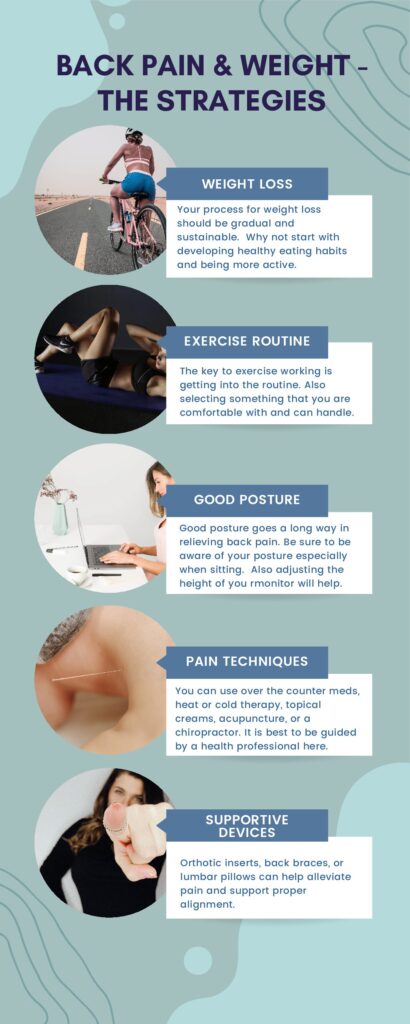
Back pain and weight is a connection not to be missed. Back pain is a common health issue that can significantly impact one’s quality of life. While multiple factors contribute to back pain, one often overlooked aspect is body weight. Excess weight places added stress on the spine and can lead to or magnify back pain. In this blog post, we will delve into the connection between weight and back pain. Understand the reason why weight affects the spine. Explore the specific types of back pain that go along with weight. Finally discuss effective options for doing something about back pain related to weight.
The Impact On The Spine
Excess weight places more strain on the spine, specifically the vertebrae, discs, and supporting structures. The added load can disrupt the natural alignment of the spine, compress the discs, and lead to spinal degeneration. The lumbar region, or lower back, is particularly susceptible to weight-related stress. This is due to its role in supporting the upper body and bearing the weight of the torso. Over time, this can result in various types of back pain, including muscle strain, herniated discs, spinal stenosis, and osteoarthritis.
How do you live your best life? By living your life healthy!! Check us out here.
Back Pain and Weight – The Types
- Mechanical Back Pain: Excess weight can lead to mechanical back pain, which is caused by unusual stress on the spine’s structures. This can include muscle imbalances, ligament sprains, and joint irritation. Individuals with obesity often experience muscle strain. This is due to the increased load placed on their back muscles while doing routine activities.
- Herniated Discs: The excess weight can contribute to the degeneration and weakening of the intervertebral discs. This makes them more prone to herniation. When a disc herniates, the gel-like center protrudes, pressing on nearby nerves and causing localized or radiating back pain.
- Spinal Stenosis: Weight-related pressure on the spinal canal can lead to spinal stenosis. Which is a narrowing of the open spaces within the spine. This narrowing can compress the nerves and cause pain, numbness, or weakness in the back, buttocks, and legs.
- Osteoarthritis: Excess weight can accelerate the degeneration of the joints, including the facet joints in the spine. Osteoarthritis can cause back pain as the protective cartilage in the joints wears down, resulting in bone-on-bone contact and inflammation.
Back Pain and Weight – The Strategies

- Weight Loss: Losing weight is a key strategy for managing and preventing weight-related back pain. A gradual and sustainable weight loss approach, incorporating a healthy diet and regular physical activity, can help reduce the strain on the spine and alleviate back pain. Consultation with a healthcare professional or a registered dietitian can provide personalized guidance and support in achieving weight loss goals.
- Exercise and Physical Activity: Engaging in regular exercise and physical activity is crucial for keeping at a healthy weight, having a strong core and back muscles, and having good spine health. Low-impact exercises such as walking, swimming, and cycling can be effective for individuals with back pain. Additionally, targeted exercises that focus on strengthening the back, core, and supporting muscles can improve stability. This goes a long way in lowering the risk of back pain.
- Posture Awareness: Maintaining good posture is important for preventing back pain, particularly for individuals carrying excess weight. Being mindful of proper alignment while standing, sitting, and lifting can reduce strain on the spine. Ergonomic adjustments, such as using supportive chairs and making sure computer screens at eye level, can also promote better posture and can end back pain.
- Pain Management Techniques: If back pain doesn’t to away or becomes chronic, various pain management techniques can provide relief. These include over-the-counter pain medications, heat or cold therapy, topical creams, and alternative therapy such as acupuncture or chiropractic care. However, it is important to consult with a healthcare professional for proper diagnosis and help in your choice of the most appropriate pain management techniques.
- Supportive Devices: In some cases, using supportive devices such as orthotic inserts, back braces, or lumbar pillows can provide additional support to the spine and alleviate back pain. These devices can help maintain proper alignment and reduce the strain on the back during daily activities.
Conclusion
The connection between weight and back pain is a significant one. Excess weight places added stress on the spine, leading to various types of back pain. However, through effective weight management, regular exercise, being aware of your posture, and pain management techniques, individuals can end and prevent back pain related to weight. It is crucial to take a complete approach, looking at both weight loss and how to strengthen the core and back muscles. By doing these things and seeking professional help when needed, individuals can reduce back pain, improve overall spine health, and enhance their overall quality of life. Remember, small lifestyle changes can make a big difference in handling back pain from weight and promoting a healthier back.
© Copyright 2023. All rights reserved.


Pingback: Back Pain Relief Through Core Exercise and Hip Therapy
Pingback: Back Pain Relief and Tight Hip Flexors, How Are They Connected?
Pingback: 60 Day Keto Diet Plan For Healthy Living
Dear, This is Kristin
Is your website getting the visibility it deserves? Our targeted SEO strategies will improve your search engine rankings, drive organic traffic, and increase conversions. Let’s chat about your SEO goals.
Skype me at: live:.cid.c3b3db85e019bd59
Find out how your rivals rank in organic and paid search: https://rebrand.ly/CompetitorsAuditor
Best regards,
Kristin
Freelance RS Agency
www rsagency online
4875 Poplar Avenue
San Diego, CA 92105
—————————————
While I am a freelancer, I’m not a pest. Don’t want to hear from me again?
Just unsubscribe now: https://rebrand.ly/UnsubscribeLink
Comments are closed.